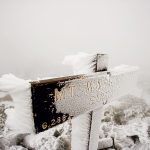Cool temperatures and spectacular views sum up why fall is my favorite season to hike. Fortunately for all of us who love the outdoors, in 1876, a small group of outdoor enthusiasts founded the
Appalachian Mountain Club (AMC). Today it is the nation’s oldest conservation and recreation organization. Its 12 chapters span the northeast from Washington, DC to Maine. The AMC has over 100,000 members, advocates, and supporters and they offer 8,000 trips a year which focus on outdoor fun. Who better to give the scoop on fall hiking, than Rob Burbank. Based in New Hampshire, he is Director of Media and Public Affairs for the AMC. He is also a member of Appalachian Mountain Club’s White Mountains Four-Thousand Footer Club for having climbed all 48 recognized peaks in New Hampshire with elevations of 4000 feet or greater.
5 Questions for Rob Burbank
Q: What are some of your earliest outdoor memories?
A: I enjoyed lots of family camping trips when I was young, and those experiences really led to what has become a lifelong interest in and involvement in the outdoors.
Q: Where’s your favorite go-to hike?
A: My first choice is New Hampshire’s Zealand Valley in the White Mountain National Forest. The area still holds tell-tale signs of the logging community that once thrived there. The valley was devastated by huge forest fires in the late 19th and early 20th centuries, but today, it’s one of the most vibrant spots in the national forest, with mixed hardwoods that offer spectacular color during the fall foliage season. Signs of moose and beavers abound, and the area is home to a wide variety of birds. It’s a real story of the regenerative power of nature. The hike to Zealand Falls is a favorite. Grades are relatively gentle, except for a short steep stretch at the approach to the falls and the Appalachian Mountain Club’s Zealand Falls Hut, which provides a nice resting spot with a fantastic view of Carrigain Notch. The hut makes a nice overnight destination, too.
Q: Which hike would you recommend to see the best foliage views?
A: The same: The 2.8-mile hike to Zealand Falls via the Zealand Trail, at the end of the Zealand Road (Forest Road 16), and the Twinway. As you hike through this mixed-hardwood forest, it’s as though you’ve become a part of an artist’s canvas; the colors just surround you. The return trip is over the same route, so it’s a 5.6-mile ’round trip.
Q: Education is a big part of AMC’s mission. What are some important things the public should know?
A: We encourage people to practice Leave No Trace principles to minimize environmental impacts. It’s important to stay on the trail to help protect surrounding vegetation, to view wildlife from a safe distance, and to carry out all that you carry in. It’s also important to wear or carry gear and clothing that will keep you warm, dry, and protected from the wind. Essential gear includes map, compass, matches or lighter, whistle, flashlight or headlamp, jackknife, and first aid kit.
Trip planning is an essential part of any hike. AMC provides a variety of tips at
www.outdoors.org/tripplanner/. We encourage folks to build a good base of outdoor skills and knowledge by taking an outdoor skills training course, reading and researching, and learning from others. Opportunities for outdoor leadership and skills training through AMC can be found at
www.outdoors.org.
Q: When you go for a hike, what do you pack for lunch?
A: When packing for a hike, I try to pack food that travels well, such as a wrap sandwich, crunchy veggies, perhaps an apple or orange. I’ll also bring along snacks, such as nuts or trail mix, to nibble on throughout the day to help maintain energy. And I always bring lots of water. Using a hands-free hydration system that slips into your pack can make it easy to sip often and helps you to stay properly hydrated.







